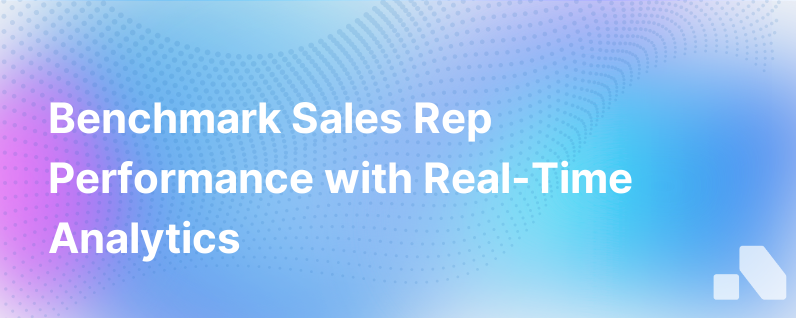
In today’s rapidly-evolving B2B landscape, the pace of business is faster than ever before. As a result, sales leaders are under increased pressure to deliver results and optimize their teams' performance constantly. With the advent of real-time data, sales organizations now have a powerful tool to benchmark rep performance and make informed decisions. But how do you effectively use this data to its full potential?
Understanding how to leverage real-time data to benchmark sales rep performance effectively can help you build a more dynamic, responsive, and ultimately, successful salesforce. Here's what you need to know.
The Power of Real-Time Data
Traditionally, sales leaders relied on quarterly or annual reports to evaluate rep performance. Today, real-time data offers insights into the daily interactions, engagement levels, and deal progress of each sales representative. These insights provide an unprecedented level of transparency, enabling sales managers to identify trends, forecast outcomes, and make swift adjustments.
The use of real-time data for performance benchmarking leads to several competitive advantages:
- Proactive Management: Instead of reacting to trends retrospectively, sales leaders can identify and act upon issues as they arise.
- Dynamic Goal Setting: Goals can be adjusted in light of real-time performance data to keep teams aiming for targets that reflect the current business climate.
- Tailored Coaching: With detailed information on each rep’s performance, coaching and training can be customized to address specific weaknesses or strengths.
Key Metrics to Track
Before you dive into the ocean of data available, pinpoint the most relevant metrics for benchmarking performance, such as:
- Call Activity: Total number of calls made, call duration, and outcomes of these interactions.
- Email Engagement: Open rates, click-through rates, and response rates of sales emails.
- Opportunities Created: Number and value of opportunities generated by each rep.
- Lead Response Time: Speed at which reps are following up on leads.
- Deal Progression: Rates at which deals move through the pipeline stages.
- Win/Loss Rates: Ratios of deals won to those lost, including reasons for loss, can provide critical insights for improvement.
- Sales Cycle Length: Average duration from initial contact to closed deal.
Establishing Benchmarks
- Internal Historical Data: Review historical performance data to establish internal benchmarks. This data provides a backdrop against which to measure current performance.
- Industry Averages: Consult industry benchmarks to determine how your team’s performance stacks up against peers. Many industry bodies and consulting firms publish regular reports on average performance metrics.
- Individual Baselines: Take into account the individual differences among sales reps. New hires, for example, may have different benchmarks compared to seasoned reps.
- Continuous Refinement: Benchmarks are not static. Continually refine them based on real-time data and evolving business strategies.
Using Real-Time Data for Performance Reviews
Switch from annual or quarterly reviews to more dynamic methods such as monthly or even weekly check-ins. These frequent touchpoints can help you address issues promptly and keep your team aligned with current goals. During these reviews, use real-time data visualizations to:
- Show reps their individual and team performance trends.
- Discuss potential areas for skill development.
- Identify best practices from top performers for team-wide learning.
- Set or adjust goals based on the current data trends and forecasts.
Encouraging a Data-Driven Culture
To get the most out of real-time data, fostering a data-driven culture within your sales team is crucial. Sales reps should understand how the data supports their success and feel empowered by it rather than threatened. Achieve this by:
- Demystifying Data: Educate your team on how to interpret and utilize data in their daily routines.
- Highlighting Positive Outcomes: Use data to celebrate successes and milestones, reinforcing a positive association with data analysis.
- Incentivizing Performance: Consider linking performance-based incentives to metric improvements, encouraging reps to engage with data actively.
Leveraging Technology
The sheer volume of real-time data can be overwhelming. That’s where advanced AI platforms like Aomni can streamline the process. These tools can:
- Aggregate data from various sources to provide a comprehensive view.
- Apply predictive analytics to forecast sales outcomes.
- Offer actionable insights tailored to each rep, helping them focus on the right activities.
- Save countless hours by automating data collection and reporting.
Conclusion
Benchmarking rep performance with real-time data is more than a technique; it's an ongoing strategy that can evolve just as quickly as the market itself. By setting realistic, dynamic benchmarks and using real-time insights, sales organizations can foster a high-performance culture that rapidly identifies and responds to changing circumstances.
This environment of continual assessment and improvement will not only drive your reps to become more effective but will also ensure your sales teams are aligned with the most current sales strategies, ultimately leading to improved sales outcomes for your entire organization.
As sales organizations harness the power of real-time data, tools like Aomni are proving indispensable. They assist sales managers by transforming data into insights and action, offering a strategically competitive edge to win in today's fast-paced B2B sales arena.